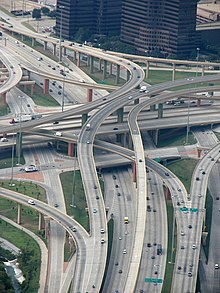Texans have historically had difficulties traversing Texas due to the state's large size and rough terrain. Texas has compensated by building both America's largest highway and railway systems in terms of length, as well as the largest number of airports. The regulatory authority, the Texas Department of Transportation (TxDOT) maintains the state's immense highway system, regulates aviation, and public transportation systems. Located centrally in North America, the state is an important transportation hub. From the Dallas/Fort Worth area, trucks can reach 93% of the nation's population within 48 hours, and 37% within 24 hours. Texas has 33 foreign trade zones (FTZ), the most in the nation. In 2004, a combined total of $298 billion of goods passed though Texas FTZs.
Highways
Texans have heavily traveled their freeways since the 1948 opening of the Gulf Freeway in Houston. As of 2005, 79,535 miles (127,999 km) of public highway crisscrossed Texas (up from 71,000 miles (114,263 km) in 1984). To fund recent growth in the state highways, Texas has 17 toll roads (see list) with several additional tollways proposed. In west Texas, both I-10 and I-20 have speed limits of 80 miles per hour (130 km/h), the highest in the nation. All federal and state highways in Texas are paved.
In March 2011, Texas ranked as a bottom-ten "Worst" state (tied with Montana and North Dakota) in the American State Litter Scorecard, presented at the American Society for Public Administration national conference. Public roadways in the Lone Star State suffer from an overall poor quality of landscape cleanliness, attributed to ineffective roadside and adjacent property litter/debris abatement standards, seemingly politicized procedural efforts, and other relevant public performance indicators.
Airports
Texas has the most airports of any state in the nation. Largest in Texas by size and passengers served, Dallas-Fort Worth International Airport (DFW) is the second largest by area in the United States, and fourth in the world with 18,076 acres (73.15 km2). In traffic, DFW is the busiest in the state and the fourth in the United States, and sixth worldwide with 26,663,984 passengers annually. AMR Corporation's American / American Eagle, the world's largest airline in total passengers-miles transported and passenger fleet size, uses DFW as its largest and main hub. Southwest Airlines, also headquartered in Dallas, has its operations currently at Dallas Love Field. It ranks as the largest airline in the United States by number of passengers carried domestically per year and the largest airline in the world by number of passengers carried.
Texas's second-largest air facility is Houston's George Bush Intercontinental Airport (IAH) with. It serves as Houston based Continental Airlines's largest hub. IAH offers service to the most Mexican destinations of any U.S. airport. The next four largest airports in the state all serve over 4 million passengers annually; they include:Austin-Bergstrom International Airport, William P. Hobby Airport, San Antonio International Airport, and Dallas Love Field. The smallest airport in the state to be designated an international airport is Del Rio International Airport.
Ports
Over 1,000 seaports dot Texas's coast with over 1,000 miles (1,600 km) of channels. Ports employ nearly one-million people and handle an average of 317 million metric tons. Texas ports connect with the rest of the U.S. Atlantic seaboard with the Gulf section of the Intracoastal Waterway. The Port of Houston today is the busiest port in the United States in foreign tonnage, second in overall tonnage, and tenth worldwide in tonnage. The Houston Ship Channel currently spans 530 feet (160 m) wide by 45 feet (14 m) deep by 50 miles (80 km) long.
Railroads
Part of the state's tradition originates from cattle drives in which wranglers herded livestock to railroads in Kansas. The first railroad to operate in Texas was the Buffalo Bayou, Brazos and Colorado Railway, opening in August 1853. The first railroad to enter Texas from the north, completed in 1872, was the Missouri–Kansas–Texas Railroad.Since 1911, Texas has led the nation in railroad length. Texas railway length peaked in 1932 at 17,078 miles (27,484 km), but declined to 14,006 miles (22,540 km) by 2000. While the Railroad Commission of Texas originally regulated state railroads, in 2005 the state reassigned these duties to TxDOT.
Both Dallas and Houston feature light rail systems. Dallas Area Rapid Transit (DART) built the first light rail system in the Southwest United States. The Trinity Railway Express (TRE) commuter rail service that links Fort Worth and Dallas is provided by the Fort Worth Transportation Authority (the T) and DART. In the Austin area Capital Metropolitan Transportation Authority operates a commuter rail service known as Capital MetroRail to the northwestern suburbs. The Metropolitan Transit Authority of Harris County, Texas (METRO) operates light rail lines in the Houston area.
Amtrak provides Texas limited intercity passenger rail service both in size and frequency. Just three scheduled routes serve the state: the daily Texas Eagle (Chicago–San Antonio); the tri-weekly Sunset Limited(New Orleans–Los Angeles), with stops in Texas; and the daily Heartland Flyer (Fort Worth–Oklahoma City).




No comments:
Post a Comment